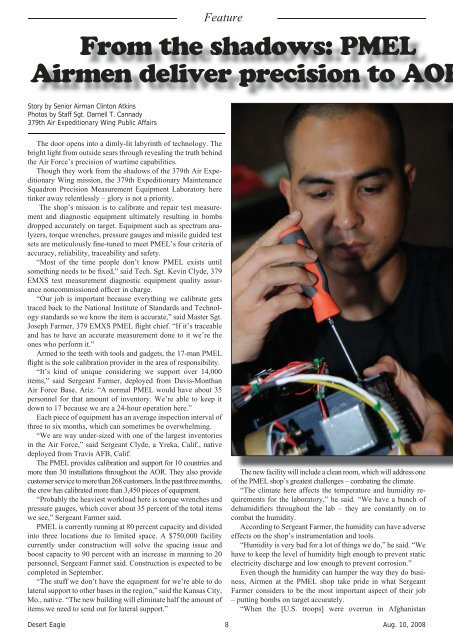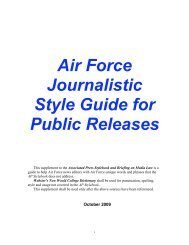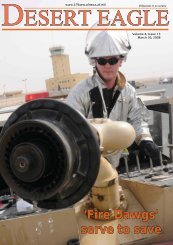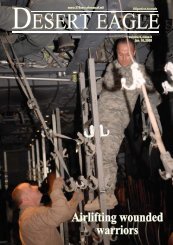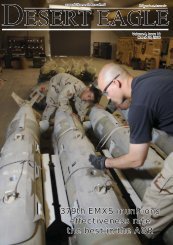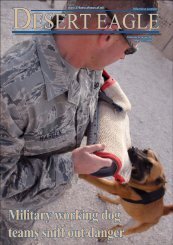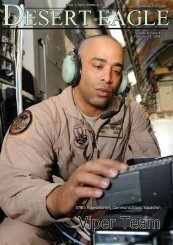Feature - 379th Air Expeditionary Wing
Feature - 379th Air Expeditionary Wing
Feature - 379th Air Expeditionary Wing
You also want an ePaper? Increase the reach of your titles
YUMPU automatically turns print PDFs into web optimized ePapers that Google loves.
Desert Eagle<br />
<strong>Feature</strong><br />
From the shadows: PMEL<br />
<strong>Air</strong>men deliver precision to AOR<br />
Story by Senior <strong>Air</strong>man Clinton Atkins<br />
Photos by Staff Sgt. Darnell T. Cannady<br />
<strong>379th</strong> <strong>Air</strong> <strong>Expeditionary</strong> <strong>Wing</strong> Public Affairs<br />
The door opens into a dimly-lit labyrinth of technology. The<br />
bright light from outside sears through revealing the truth behind<br />
the <strong>Air</strong> Force’s precision of wartime capabilities.<br />
Though they work from the shadows of the <strong>379th</strong> <strong>Air</strong> <strong>Expeditionary</strong><br />
<strong>Wing</strong> mission, the <strong>379th</strong> <strong>Expeditionary</strong> Maintenance<br />
Squadron Precision Measurement Equipment Laboratory here<br />
tinker away relentlessly – glory is not a priority.<br />
The shop’s mission is to calibrate and repair test measurement<br />
and diagnostic equipment ultimately resulting in bombs<br />
dropped accurately on target. Equipment such as spectrum analyzers,<br />
torque wrenches, pressure gauges and missile guided test<br />
sets are meticulously fi ne-tuned to meet PMEL’s four criteria of<br />
accuracy, reliability, traceability and safety.<br />
“Most of the time people don’t know PMEL exists until<br />
something needs to be fi xed,” said Tech. Sgt. Kevin Clyde, 379<br />
EMXS test measurement diagnostic equipment quality assurance<br />
noncommissioned offi cer in charge.<br />
“Our job is important because everything we calibrate gets<br />
traced back to the National Institute of Standards and Technology<br />
standards so we know the item is accurate,” said Master Sgt.<br />
Joseph Farmer, 379 EMXS PMEL fl ight chief. “If it’s traceable<br />
and has to have an accurate measurement done to it we’re the<br />
ones who perform it.”<br />
Armed to the teeth with tools and gadgets, the 17-man PMEL<br />
fl ight is the sole calibration provider in the area of responsibility.<br />
“It’s kind of unique considering we support over 14,000<br />
items,” said Sergeant Farmer, deployed from Davis-Monthan<br />
<strong>Air</strong> Force Base, Ariz. “A normal PMEL would have about 35<br />
personnel for that amount of inventory. We’re able to keep it<br />
down to 17 because we are a 24-hour operation here.”<br />
Each piece of equipment has an average inspection interval of<br />
three to six months, which can sometimes be overwhelming.<br />
“We are way under-sized with one of the largest inventories<br />
in the <strong>Air</strong> Force,” said Sergeant Clyde, a Yreka, Calif., native<br />
deployed from Travis AFB, Calif.<br />
The PMEL provides calibration and support for 10 countries and<br />
more than 30 installations throughout the AOR. They also provide<br />
customer service to more than 268 customers. In the past three months,<br />
the crew has calibrated more than 3,450 pieces of equipment.<br />
“Probably the heaviest workload here is torque wrenches and<br />
pressure gauges, which cover about 35 percent of the total items<br />
we see,” Sergeant Farmer said.<br />
PMEL is currently running at 80 percent capacity and divided<br />
into three locations due to limited space. A $750,000 facility<br />
currently under construction will solve the spacing issue and<br />
boost capacity to 90 percent with an increase in manning to 20<br />
personnel, Sergeant Farmer said. Construction is expected to be<br />
completed in September.<br />
“The stuff we don’t have the equipment for we’re able to do<br />
lateral support to other bases in the region,” said the Kansas City,<br />
Mo., native. “The new building will eliminate half the amount of<br />
items we need to send out for lateral support.”<br />
The new facility will include a clean room, which will address one<br />
of the PMEL shop’s greatest challenges – combating the climate.<br />
“The climate here affects the temperature and humidity requirements<br />
for the laboratory,” he said. “We have a bunch of<br />
dehumidifi ers throughout the lab – they are constantly on to<br />
combat the humidity.<br />
According to Sergeant Farmer, the humidity can have adverse<br />
effects on the shop’s instrumentation and tools.<br />
“Humidity is very bad for a lot of things we do,” he said. “We<br />
have to keep the level of humidity high enough to prevent static<br />
electricity discharge and low enough to prevent corrosion.”<br />
Even though the humidity can hamper the way they do business,<br />
<strong>Air</strong>men at the PMEL shop take pride in what Sergeant<br />
Farmer considers to be the most important aspect of their job<br />
– putting bombs on target accurately.<br />
“When the [U.S. troops] were overrun in Afghanistan<br />
8 Aug. 10, 2008


